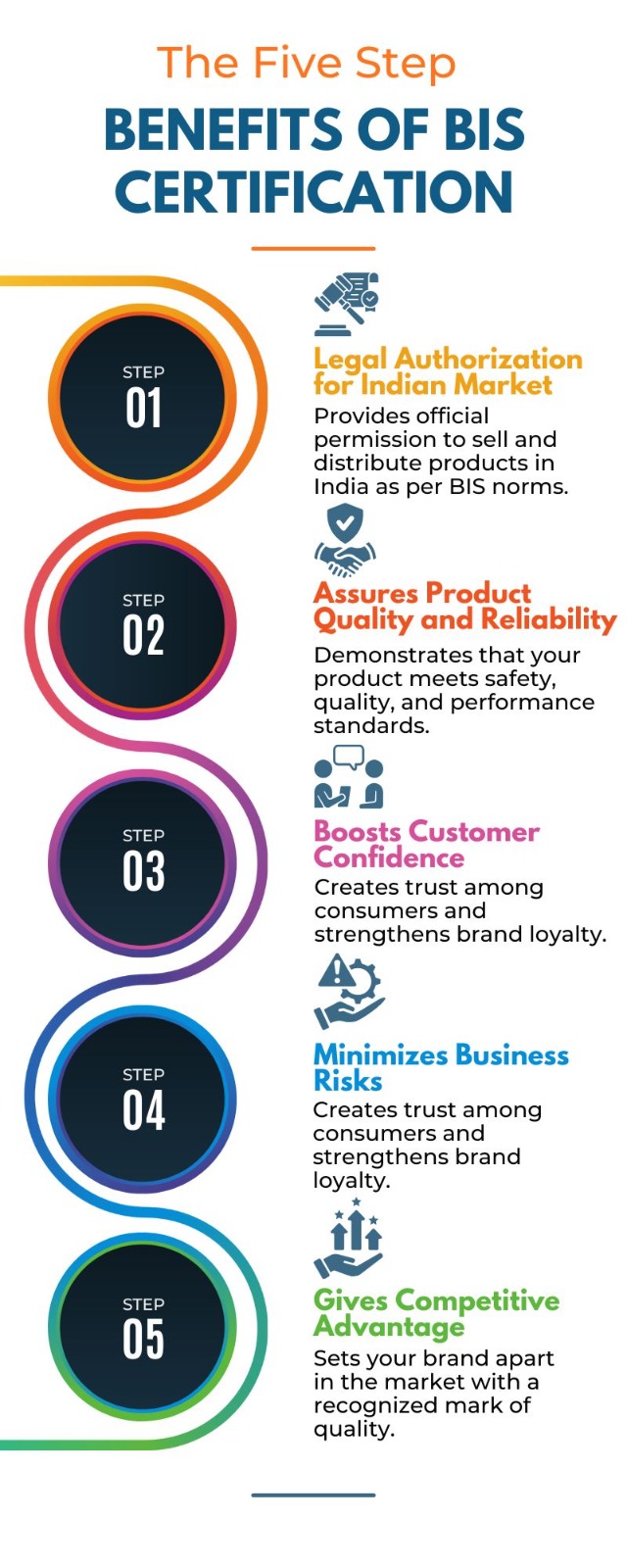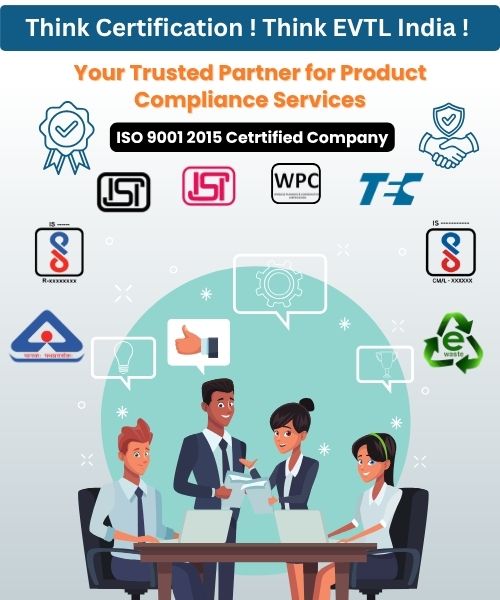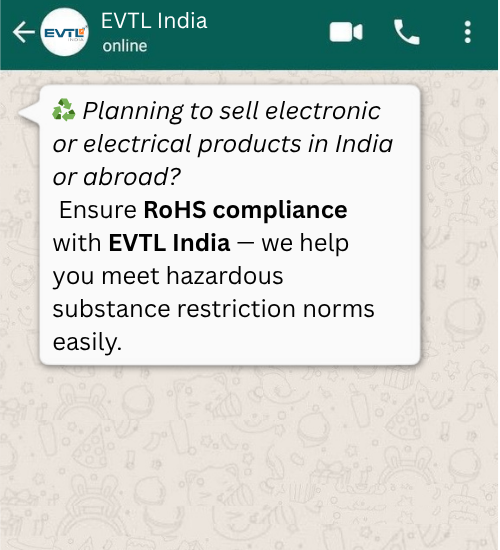Get A Quote
RoHS (Restriction of Hazardous Substances)
Looking to manage electronic waste and need a RoHS certificate? EVTL India offers full support for hassle-free RoHS registration, ensuring compliance with safety and environmental standards. With EVTL's expertise, you can easily meet regulatory requirements and contribute to a safer, eco-friendly approach to electronics.

- Overview
- What is RoHS Certification?
- RoHS in India: Addressing Growing Electronic Waste
- Why Was RoHS Introduced?
- Who Must Comply with RoHS?
- Scope of RoHS Compliance
- Exemptions and Exclusions
- Substances Restricted by RoHS
- Steps for Achieving RoHS Compliance
- RoHS and CE Marking
- Consequences of Non-Compliance
- RoHS Exemptions Explained
- RoHS Outside the EU
- RoHS Testing and Verification
- Conclusion
- Frequently Asked Question (FAQ)
RoHS (Restriction of Hazardous Substances) - Overview
Since the early 2000s, electronic waste and the use of hazardous chemicals in electronics have become increasingly common. Substances like radium for glow-in-the-dark features or lead-tin alloys for soldering offered benefits, but few people realized the dangers they posed to health and the environment. Over time, exposure to these toxic substances has been linked to serious health problems, including lung cancer and other diseases. Recognizing these risks, the European Union (EU) introduced the Restriction of Hazardous Substances, or RoHS, in February 2003 to limit the use of certain toxic materials in electronics.

The RoHS directive became effective on July 1, 2006, and EU member countries were required to make it law within their own borders. RoHS restricts certain harmful chemicals in electrical and electronic equipment, aiming to reduce the environmental and health impacts of these products. The main goal behind RoHS is to create safer electronics by reducing the use of hazardous substances.
What is RoHS Certification?
RoHS, or the "Restriction of Hazardous Substances," is also known as Directive 2002/95/EC. This directive restricts the use of specific harmful substances in electrical and electronic products. RoHS is closely linked to the WEEE (Waste Electrical and Electronic Equipment) regulations, which set rules for managing electronic waste safely. Together, RoHS and WEEE work to reduce pollution from electronics and protect public health.
RoHS in India: Addressing Growing Electronic Waste
In India, the demand for electronic products has surged, leading to growing concerns about the health and environmental effects of electronic waste. New technologies encourage consumers to frequently replace devices, creating vast amounts of e-waste. To address this issue, the Ministry of Environment and Forests (MoEF) and the Government of India introduced guidelines similar to RoHS. Known locally as "Electronic Waste Management," these guidelines restrict hazardous substances in electronics sold or produced in India.
If you manufacture or import electronic products in India, you may have specific responsibilities under WEEE or RoHS-like regulations. The requirements depend on the size of your company and the types of devices involved. By following these guidelines, companies can help protect both people and the environment from the harmful effects of electronic waste.
Why Was RoHS Introduced?
The electronics industry has historically relied on materials that pose significant health and environmental risks if not managed carefully. RoHS was introduced for three main reasons:
- Reducing Toxic Waste: Electronic waste, or e-waste, can contain harmful chemicals like lead and mercury. When improperly disposed of, these substances can leach into soil and water, contaminating ecosystems and posing risks to human health. RoHS minimizes these toxins in landfills.
- Improving Worker Safety: Manufacturing electronic devices often requires handling hazardous substances. RoHS promotes safer manufacturing environments by reducing workers' exposure to toxic chemicals.
- Encouraging Eco-Friendly Design: RoHS pushes manufacturers to find sustainable alternatives, leading to less-toxic product design. This change not only benefits the environment but also aligns with consumer demand for greener products.
Who Must Comply with RoHS?
RoHS compliance is mandatory for any business manufacturing, importing, or distributing EEE in India. The requirements apply to various companies in the supply chain:
- Manufacturers: Companies that produce electronic goods intended for Indian markets are responsible for ensuring their products meet RoHS standards.
- Importers: Businesses that import electronics from outside India must verify RoHS compliance for each product, ensuring that it meets regulatory standards.
- Distributors: Indian distributors are also accountable for ensuring that all products they sell adhere to RoHS regulations.
Scope of RoHS Compliance
RoHS compliance covers a broad range of electronic and electrical equipment, including consumer electronics, appliances, medical devices, and more:
- Consumer Electronics: Includes phones, computers, gaming consoles, and TVs.
- Household Appliances: Examples are refrigerators, washing machines, and microwaves.
- Industrial Equipment: Machinery and control systems used in industrial settings.
- Medical Devices: Diagnostic equipment, patient monitoring systems, and imaging technology.
- Telecommunications Equipment: Routers, switches, and other network devices.
- Automotive Electronics: Entertainment systems, GPS units, and control modules within vehicles.
- Lighting Products: LED bulbs and fluorescent lights.
- Toys: Electrical toys and devices for recreational use.
While RoHS covers a wide variety of products, certain categories are excluded or exempt for safety, technological, or logistical reasons.
Exemptions and Exclusions
RoHS includes specific exemptions to accommodate devices with unique requirements. These exemptions allow certain materials to be used in cases where substitution is not feasible or would compromise safety:
- Military and Defense Equipment: Devices essential to national security are exempt.
- Space Equipment: Devices explicitly designed for space applications are excluded.
- Scientific Instruments: Research and testing tools used in laboratories often have unique needs.
- Research and Development Equipment: Often exempt, particularly if only available for business-to-business use.
RoHS exemptions are typically time-limited, giving manufacturers time to develop safer alternatives.
Substances Restricted by RoHS
RoHS targets ten substances known to pose health and environmental risks, often referred to as the “RoHS 10”:
- Lead (Pb): Commonly used in solder, lead can harm the nervous system and kidneys.
- Mercury (Hg): Found in switches and fluorescent lights, mercury is highly toxic, especially to the nervous system.
- Cadmium (Cd): Present in batteries and pigments, cadmium is a carcinogen and environmental pollutant.
- Hexavalent Chromium (Cr6+): Used for corrosion resistance, it is toxic to humans and harmful to the environment.
- Polybrominated Biphenyls (PBB): Flame retardants known to be harmful when inhaled or absorbed through the skin.
- Polybrominated Diphenyl Ethers (PBDE): Another harmful flame retardant.
- Bis(2-Ethylhexyl) Phthalate (DEHP): A plasticizer linked to reproductive issues.
- Benzyl Butyl Phthalate (BBP): Another plasticizer posing reproductive risks.
- Dibutyl Phthalate (DBP): Used in adhesives and disrupts endocrine functions.
- Diisobutyl Phthalate (DIBP): Used in coatings and adhesives, posing reproductive risks.
For each material, RoHS mandates that the concentration must not exceed 0.1% (except cadmium, which is capped at 0.01%) by weight in any individual component.
Steps for Achieving RoHS Compliance
Achieving RoHS compliance requires careful planning and adherence to specific steps:
- Assess Materials: Evaluate all materials and components for restricted substances.
- Test Substances: Conduct testing if there’s uncertainty about a component’s composition.
- Obtain Supplier Declarations: Suppliers should provide detailed declarations confirming the RoHS status of their materials.
- Maintain Documentation: Keep records, including test reports and declarations, to prove compliance if needed.
- Issue Declaration of Conformity (DoC): The DoC certifies that a product meets RoHS standards.
- Labeling: Many RoHS-compliant products carry the “CE” mark and other identifiers to ensure traceability.
- Ongoing Monitoring: Compliance is an ongoing process. Regular testing and supplier checks are essential to ensure continued compliance.
For each material, RoHS mandates that the concentration must not exceed 0.1% (except cadmium, which is capped at 0.01%) by weight in any individual component.
RoHS and CE Marking
RoHS compliance is crucial for obtaining CE marking on applicable products. CE marking is required for a range of goods sold in the EU and signifies that the product meets health, safety, and environmental protection standards, including RoHS. Non-compliance with RoHS means the product cannot carry the CE mark, and it may be banned from EU markets.
Consequences of Non-Compliance
Failing to comply with RoHS can have significant consequences:
- Market Bans: Non-compliant products may be removed from the EU market.
- Fines: EU regulatory bodies can impose fines on companies that breach RoHS.
- Recalls: Products may be recalled if they are found to be in violation of RoHS requirements.
- Legal Action: Companies may face lawsuits, and non-compliance could harm their reputation.
- Environmental Impact: Products that don’t meet RoHS requirements contribute to higher toxic waste in landfills, posing greater risks to ecosystems and public health.
RoHS Exemptions Explained
Certain exemptions allow restricted substances to be used in specific cases, often for technical or safety reasons. Exemptions are sometimes temporary to give manufacturers time to find alternatives. Examples include:
- Cadmium in LEDs for displays
- Lead in solder for high-reliability applications
These exemptions are subject to review, and the EU periodically re-evaluates them based on technological advancements.
RoHS Outside the EU
Though RoHS originated in the EU, many other countries have adopted similar regulations. The United States, China, Japan, and South Korea have each implemented standards to regulate hazardous substances in electronics. While RoHS does not directly apply outside the EU, international manufacturers who sell in the EU or other regions with similar regulations must meet these requirements.
RoHS Testing and Verification
Testing for RoHS compliance often involves:
- X-Ray Fluorescence (XRF) Analysis: This non-destructive testing method detects metals in components.
- Chemical Testing: Solvent extraction and chemical analysis are required for certain substances, like phthalates, to ensure accuracy.
Conclusion:
RoHS is more than just a regulatory hurdle—it represents a global shift toward safer, more sustainable electronics. By requiring companies to reduce or eliminate hazardous materials, RoHS has encouraged safer production practices, spurred technological innovation, and protected both consumers and the environment.
For businesses aiming to comply, understanding the RoHS requirements and maintaining regular testing and monitoring practices is essential. As global regulations evolve, RoHS remains a cornerstone of environmental and health protection in the electronics industry, setting the standard for safer, greener electronics worldwide.
Frequently Asked Questions (FAQ)
Our Services
Testimonials
News & Updates









